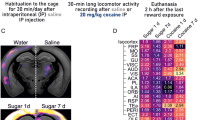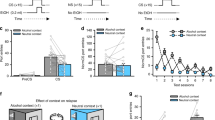Abstract
A challenge in treating drug addicts is preventing their pathological motivation for the drug without impairing their general affective state toward natural reinforcers. Here we have shown that discrete lesions of the subthalamic nucleus greatly decreased the motivation of rats for cocaine while increasing it for food reward. The subthalamic nucleus, a key structure controlling basal ganglia outputs, is therefore able to oppositely modulate the effect of 'natural' rewards and drugs of abuse on behavior. Modulating the activity of the subthalamic nucleus might prove to be a new target for the treatment of cocaine addiction.
This is a preview of subscription content, access via your institution
Access options
Subscribe to this journal
Receive 12 print issues and online access
$209.00 per year
only $17.42 per issue
Buy this article
- Purchase on Springer Link
- Instant access to full article PDF
Prices may be subject to local taxes which are calculated during checkout





Similar content being viewed by others
References
Hollerman, J.R., Tremblay, L. & Schultz, W. Influence of reward expectation on behavior-related neuronal activity in primate striatum. J. Neurophysiol. 80, 947–963 (1998).
Hassani, O.K., Cromwell, H.C. & Schultz, W. Influence of expectation of different rewards on behavior-related neuronal activity in the striatum. J. Neurophysiol. 85, 2477–2489 (2001).
Ito, R., Dalley, J.W., Robbins, T.W. & Everitt, B.J. Dopamine release in the dorsal striatum during cocaine-seeking behavior under the control of a drug-associated cue. J. Neurosci. 22, 6247–6253 (2002).
Porrino, L.J., Lyons, D., Smith, H.R., Daunais, J.B. & Nader, M.A. Cocaine self-administration produces a progressive involvement of limbic, association, and sensorimotor striatal domains. J. Neurosci. 24, 3554–3562 (2004).
Limousin, P. et al. Effects on parkinsonian signs and symptoms of bilateral subthalamic nucleus stimulation. Lancet 345, 91–95 (1995).
Bergman, H., Wichmann, T. & DeLong, M.R. Reversal of experimental parkinsonism by lesion of the subthalamic nucleus. Science 249, 1436–1438 (1990).
Benazzouz, A., Gross, C., Féger, J., Boraud, T. & Bioulac, B. Reversal of rigidity and improvement in motor performance by subthalamic high-frequency stimulation in MPTP-treated monkeys. Eur. J. Neurosci. 5, 382–389 (1993).
Baunez, C., Nieoullon, A. & Amalric, M. In a rat model of parkinsonism, lesions of the subthalamic nucleus reverse increases of reaction time, but induce a dramatic premature responding deficit. J. Neurosci. 15, 6531–6541 (1995).
Henderson, J.M. et al. Subthalamic nucleus lesions induce deficits as well as benefits in the hemiparkinsonian rat. Eur. J. Neurosci. 11, 2749–2757 (1999).
Krack, P. et al. What is the influence of subthalamic nucleus stimulation on the limbic loop? in Basal Ganglia and Thalamus in Health and Movement Disorders (eds. Kultas-Ilinsky, K. & Ilinsky, I.A.) 333–340 (Kluwer Academic/Plenum, New York, 2001).
Trépanier, L.L., Kumar, R., Lozano, A.M., Lang, A.E. & Saint-Cyr, J.A. Neuropsychological outcome of GPi pallidotomy and GPi or STN deep brain stimulation in Parkinson's Disease. Brain Cogn. 42, 324–347 (2000).
Trillet, M., Vighetto, A., Croisile, B., Charles, N. & Aimard, G. Hemiballismus with logorrhea and thymo-affective disinhibition caused by hematoma of the left subthalamic nucleus. Rev. Neurol. (Paris) 151, 416–419 (1995).
Absher, J.R. et al. Hypersexuality and hemiballism due to subthalamic infarction. Neuropsychiatry Neuropsychol. Behav. Neurol. 13, 220–229 (2000).
Moro, E. et al. Chronic subthalamic nucleus stimulation reduces medication requirements in Parkinson's disease. Neurology 53, 85–90 (1999).
Baunez, C., Amalric, M. & Robbins, T.W. Enhanced food-related motivation after bilateral lesions of the subthalamic nucleus. J. Neurosci. 22, 562–568 (2002).
Pontieri, F.E., Mainero, C., La Riccia, M., Passarelli, F. & Orzi, F. Functional correlates of repeated administration of cocaine and apomorphine in the rat. Eur. J. Pharmacol. 284, 205–209 (1995).
Uslaner, J.M., Crombag, H.S., Ferguson, S.M. & Robinson, T.E. Cocaine-induced psychomotor activity is associated with its ability to induce c-fos mRNA expression in the subthalamic nucleus: effects of dose and repeated treatment. Eur. J. Neurosci. 17, 2180–2186 (2003).
Darbaky, Y., Forni, C., Amalric, M. & Baunez, C. High frequency stimulation of the subthalamic nucleus has beneficial antiparkinsonian effects on motor functions in rats, but less efficiency in a choice-reaction time task. Eur. J. Neurosci. 18, 951–956 (2003).
Lorrain, D.S., Arnold, G.M. & Vezina, P. Previous exposure to amphetamine increases incentive to obtain the drug: long-lasting effects revealed by the progressive ratio schedule. Behav. Brain Res. 107, 9–19 (2000).
Vezina, P. Sensitization of midbrain dopamine neuron reactivity and the self-administration of psychomotor stimulant drugs. Neurosci. Biobehav. Rev. 27, 827–839 (2004).
Hodos, W. Progressive ratio as a measure of reward strength. Science 134, 943–944 (1961).
Baunez, C. & Robbins, T.W. Bilateral lesions of the subthalamic nucleus induce multiple deficits in attentional performance in rats. Eur. J. Neurosci. 9, 2086–2099 (1997).
Baunez, C. & Robbins, T.W. Effects of transient inactivation of the subthalamic nucleus by local muscimol and APV infusions on performance on the five-choice serial reaction time task in rats. Psychopharmacology (Berl.) 141, 57–65 (1999).
Whittier, J.R. Ballism and the subthalamic nucleus (nucleus hypothalamicus; corpus Luysii). Arch. Neurol. Psychiatry 58, 672–692 (1947).
Phillips, J.M. & Brown, V.J. Reaction time performance following unilateral striatal dopamine depletion and lesions of the subthalamic nucleus in the rat. Eur. J. Neurosci. 11, 1003–1010 (1999).
Carelli, R.M., Ijames, S.G. & Crumling, A.J. Evidence that separate neural circuits in the nucleus accumbens encode cocaine versus “natural” (water and food) reward. J. Neurosci. 20, 4255–4266 (2000).
Carelli, R.M. Nucleus accumbens cell firing during goal-directed behaviors for cocaine vs. 'natural' reinforcement. Physiol. Behav. 76, 379–387 (2002).
Bowman, E.M., Aigner, T.G. & Richmond, B.J. Neural signals in the monkey ventral striatum related to motivation for juice and cocaine rewards. J. Neurophysiol. 75, 1061–1073 (1996).
Maurice, N., Deniau, J.M., Menetrey, A., Glowinski, J. & Thierry, A.M. Prefrontal cortex-basal ganglia circuits in the rat: involvement of ventral pallidum and subthalamic nucleus. Synapse 29, 363–370 (1998).
Maurice, N., Deniau, J.M., Glowinski, J. & Thierry, A.M. Relationships between the prefrontal cortex and the basal ganglia in the rat: physiology of the corticosubthalamic circuits. J. Neurosci. 18, 9539–9546 (1998).
Alexander, G.E., Crutcher, M.D. & DeLong, M.R. Basal ganglia-thalamocortical circuits: parallel substrates for motor, oculomotor, “prefrontal” and “limbic” functions. Prog. Brain Res. 85, 119–146 (1990).
Groenewegen, H.J. & Berendse, H.W. Connections of the subthalamic nucleus with ventral striatopallidal parts of the basal ganglia in the rat. J. Comp. Neurol. 294, 607–622 (1990).
Turner, M.S., Lavin, A., Grace, A.A. & Napier, T.C. Regulation of limbic information outflow by the subthalamic nucleus: excitatory amino acid projections to the ventral pallidum. J. Neurosci. 21, 2820–2832 (2001).
Piazza, P.V., Deroche-Gamonet, V., Rouge-Pont, F. & Le Moal, M. Vertical shifts in self-administration dose-response functions predict a drug-vulnerable phenotype predisposed to addiction. J. Neurosci. 20, 4226–4232 (2000).
Ahmed, S.H. & Koob, G.F. Transition from moderate to excessive drug intake: change in hedonic set point. Science 282, 298–300 (1998).
Robledo, P. & Koob, G.F. Two discrete nucleus accumbens projection areas differentially mediate cocaine self-administration in the rat. Behav. Brain Res. 55, 159–166 (1993).
Pontieri, F.E., Tanda, G. & Di Chiara, G. Intravenous cocaine, morphine, and amphetamine preferentially increase extracellular dopamine in the “shell” as compared with the “core” of the rat nucleus accumbens. Proc. Natl. Acad. Sci. USA 92, 12304–12308 (1995).
Cardinal, R.N., Parkinson, J.A., Hall, J. & Everitt, B.J. Emotion and motivation: the role of the amygdala, ventral striatum, and prefrontal cortex. Neurosci. Biobehav. Rev. 26, 321–352 (2002).
Di Chiara, G. Nucleus accumbens shell and core dopamine: differential role in behavior and addiction. Behav. Brain Res. 137, 75–114 (2002).
Ito, R., Robbins, T.W. & Everitt, B.J. Differential control over cocaine-seeking behavior by nucleus accumbens core and shell. Nat. Neurosci. 7, 389–397 (2004).
Tanaka, S.C. et al. Prediction of immediate and future rewards differentially recruits cortico-basal ganglia loops. Nat. Neurosci. 7, 887–893 (2004).
Schultz, W., Tremblay, L. & Hollerman, J.R. Reward processing in primate orbitofrontal cortex and basal ganglia. Cereb. Cortex 10, 272–283 (2000).
Izquierdo, A., Suda, R.K. & Murray, E.A. Bilateral orbital prefrontal cortex lesions in rhesus monkeys disrupt choices guided by both reward value and reward contingency. J. Neurosci. 24, 7540–7548 (2004).
Bolla, K.I. et al. Orbitofrontal dysfunction in abstinent cocaine abusers performing a decision-making task. Neuroimage 19, 1085–1094 (2003).
Volkow, N.D. & Fowler, J.S. Addiction, a disease of compulsion and drive: involvement of the orbitofrontal cortex. Cereb. Cortex 10, 318–325 (2000).
Volkow, N.D., Fowler, J.S., Wang, G-J. & Goldstein, R. Role of dopamine, the frontal cortex and memory circuits in drug addiction: insight from imaging studies. Neurobiol. Learn. Mem. 78, 610–624 (2002).
Chudasama, Y., Baunez, C. & Robbins, T.W. Functional disconnection of the medial prefrontal cortex and subthalamic nucleus in attentional performance: Evidence for cortico-subthalamic interaction. J. Neurosci. 23, 5477–5485 (2003).
Mallet, L. et al. Compulsions, Parkinson's disease, and stimulation. Lancet 360, 1302–1304 (2002).
Paxinos, G. & Watson, C. The Rat Brain in Stereotaxic Coordinates 2nd edn. (Academic, Sydney, 1986).
Depoortere, R.Y., Li, D.H., Lane, J.D. & Emmett-Oglesby, M.W. Parameters of self-administration of cocaine in rats under a progressive-ratio schedule. Pharmacol. Biochem. Behav. 45, 539–548 (1993).
Acknowledgements
This study was supported by the Centre National de la Recherche Scientifique, a European Community 5th PCRDT program funding (QLK6-1999-02173), and by the Fondation France Parkinson and Conseil Régional d'Aquitaine. The authors thank P.V. Piazza for critical reading and corrections of the manuscript; B. J. Everitt, T.W. Robbins, S.H. Ahmed and L. Vanderschuren for discussion of the results and manuscript; and Y. Darbaky and R. LeCozannet for help.
Author information
Authors and Affiliations
Corresponding author
Ethics declarations
Competing interests
The authors declare no competing financial interests.
Rights and permissions
About this article
Cite this article
Baunez, C., Dias, C., Cador, M. et al. The subthalamic nucleus exerts opposite control on cocaine and 'natural' rewards. Nat Neurosci 8, 484–489 (2005). https://doi.org/10.1038/nn1429
Received:
Accepted:
Published:
Issue Date:
DOI: https://doi.org/10.1038/nn1429
This article is cited by
-
Architecture of the subthalamic nucleus
Communications Biology (2024)
-
A subthalamo-parabrachial glutamatergic pathway is involved in stress-induced self-grooming in mice
Acta Pharmacologica Sinica (2023)
-
Alcohol-specific transcriptional dynamics of memory reconsolidation and relapse
Translational Psychiatry (2023)
-
Peer presence and familiarity as key factors to reduce cocaine intake in both rats and humans: an effect mediated by the subthalamic nucleus
Psychopharmacology (2022)
-
Is Deep Brain Stimulation an Effective Treatment for Psychostimulant Dependency? A Preclinical and Clinical Systematic Review
Neurochemical Research (2022)



